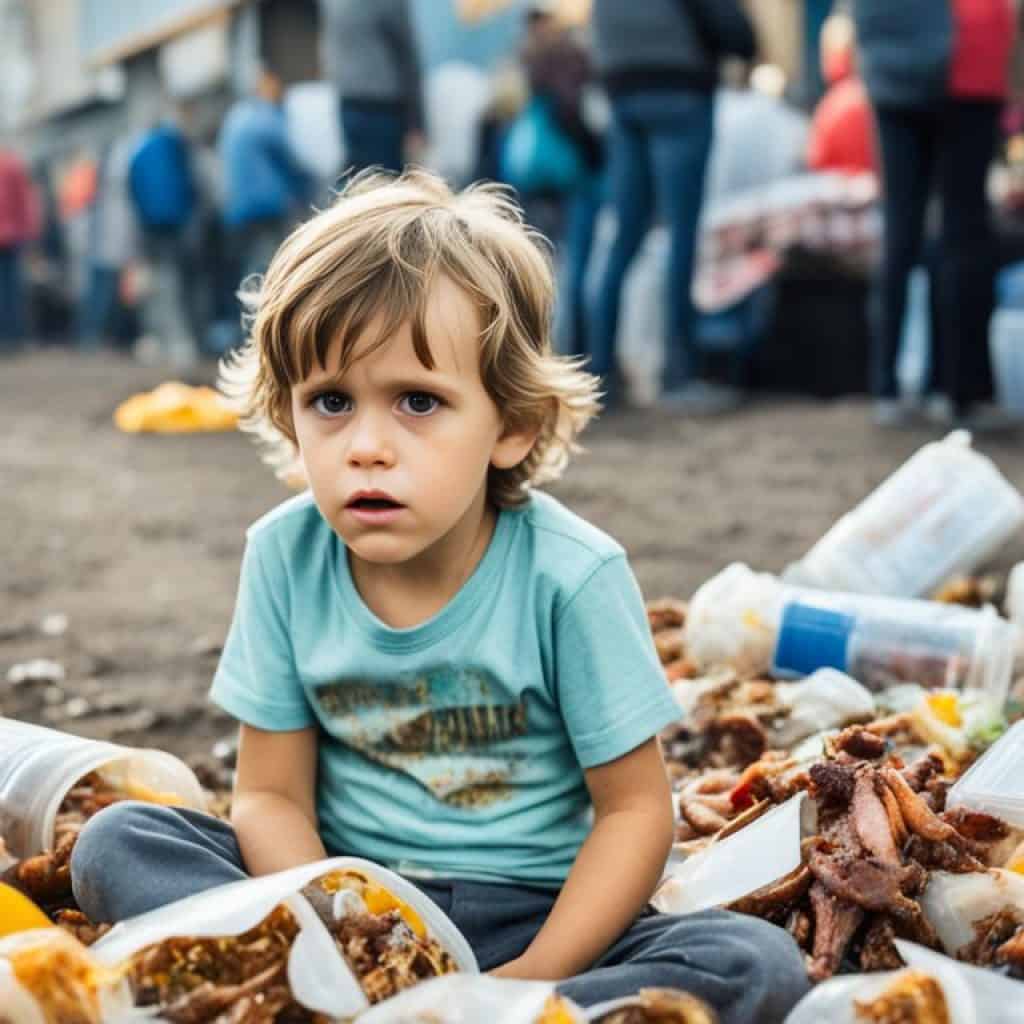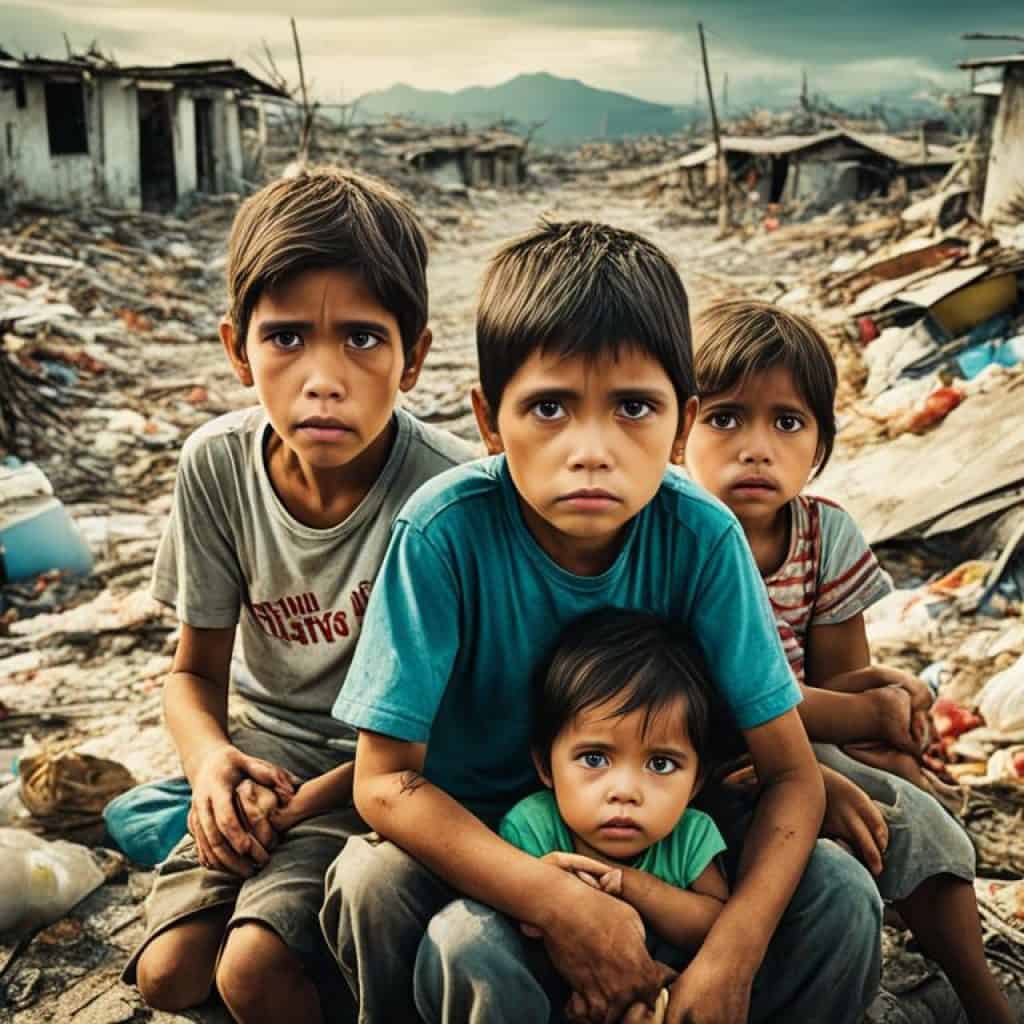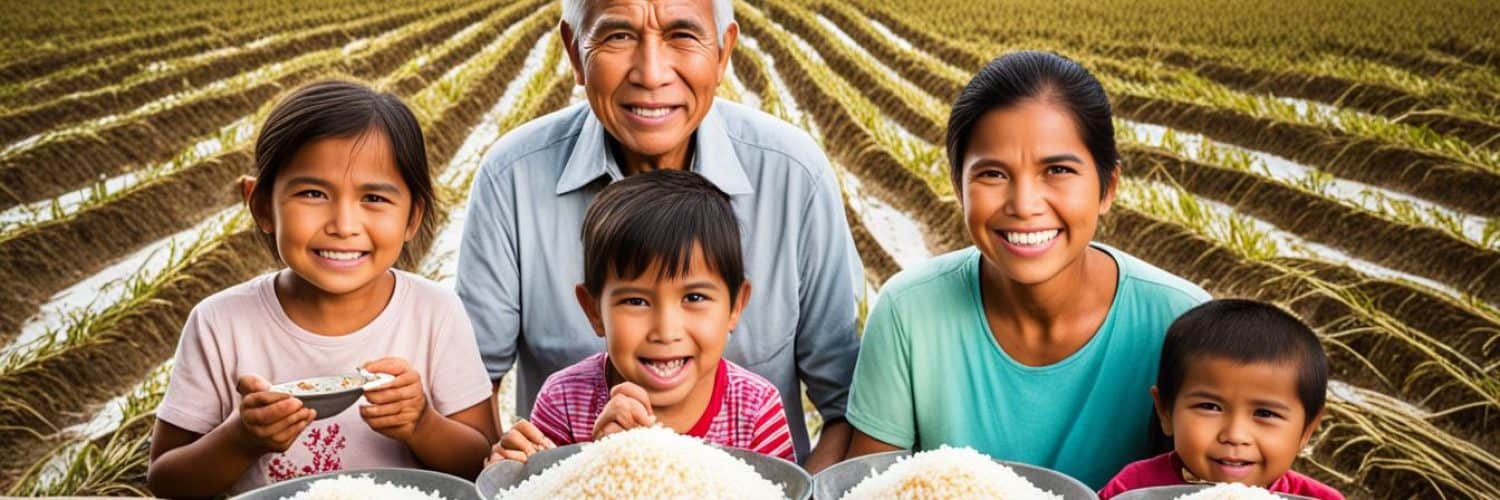Did you know that one in 10 households in the Philippines experiences food insecurity? Despite being known as the “The Rice Bowl of Asia,” the country faces a staggering food scarcity and hunger issues. The malnutrition crisis, poverty, and hunger levels in the Philippines are alarming, leaving millions of Filipinos at risk of starvation. But what are the underlying factors contributing to this Filipino food crisis, and what can be done to address it?
In this article, we delve into the history of hunger in the Philippines, the disproportionate impact on the poorest, the worsening hunger crisis, and the specific challenges faced by Filipino children. We also explore relief efforts and international aid, the prevalence of food insecurity in the country and Southeast Asia, as well as the limited options for fighting inflation. Finally, we discuss the vulnerability of the Philippines and future solutions to confront this pressing issue.
Join us as we uncover the complex web of factors that contribute to food insecurity in the Philippines and explore potential solutions to alleviate hunger and malnutrition.
Key Takeaways:
- Food insecurity affects one in 10 households in the Philippines, posing a significant challenge to the nation’s well-being.
- The poorest in the country, especially those reliant on agriculture, are the most vulnerable to hunger and food insufficiency.
- Hunger in the Philippines has worsened in recent years due to increasing population, limited resources, natural disasters, and the impact of the COVID-19 pandemic.
- Undernutrition in Filipino children hinders their cognitive development and has broader implications for human and economic development.
- International aid organizations and the US play a crucial role in providing relief efforts and support to address food insecurity in the Philippines.
History of Hunger in the Philippines
The Philippines has a long and tumultuous history of food scarcity, marked by devastating famines and severe typhoons that have led to mass starvation, social upheaval, and widespread disease. These events have not only affected specific regions but have also had a significant impact on the nation as a whole.
One of the most notable incidents in the country’s history is the series of typhoons that struck in 1972, leaving a trail of destruction in their wake. These natural disasters resulted in widespread displacement, destroyed crops, and disrupted the food supply chain. The aftermath of these typhoons led to a severe food shortage, exacerbating existing hunger issues and causing starvation rates to soar.
In the early 1990s, the Philippines faced another wave of disasters, with devastating volcanic eruptions and earthquakes triggering a series of famines. These famines resulted in a significant loss of agricultural productivity, leading to food scarcity and an alarming increase in starvation rates.
“Hunger has haunted our nation for decades, with typhoons and famines leaving a lasting impact on the lives of our people. These crises, marked by food scarcity and mass starvation, have instilled a sense of resilience in the Filipino spirit.”– President Rodrigo Duterte
These historical events highlight the vulnerability of the Philippines to natural disasters and their destructive consequences on food availability and access. They also shed light on the urgent need to address underlying issues such as poverty, inadequate infrastructure, and climate change, which contribute to food insecurity in the country.
Disproportionate Impact on the Poorest
The impact of food insecurity in the Philippines is most severe among the poorest segments of society, particularly those in agriculture households. These vulnerable communities rely heavily on agriculture for their income and sustenance, making them highly susceptible to fluctuations in food availability and prices.
Compounding the problem is the uneven distribution of wealth, which exacerbates the food insecurity rates. A staggering 25% of agricultural households experience food insecurity, compared to just 9% of non-agricultural households. This disparity highlights the urgent need for targeted intervention and support to address the specific challenges faced by the poorest segments of the population.
To illustrate the extent of this issue, consider the following data:
| Group | Food Insecurity Rate |
|---|---|
| Agricultural Households | 25% |
| Non-Agricultural Households | 9% |
As seen in the table above, the disparity in food insecurity rates between agricultural and non-agricultural households highlights the disproportionate impact on the poorest communities.
This alarming situation calls for targeted interventions that address the specific needs of agriculture households and prioritize inclusive economic growth to uplift the most vulnerable. By focusing on improving opportunities and resources for these communities, we can reduce food insecurity rates and enhance overall societal well-being.
In the next section, we will delve into the worsening hunger crisis in the Philippines and explore the various factors contributing to this immense challenge.

Worsening Hunger Crisis
Hunger in the Philippines has worsened in recent years, presenting a growing challenge for the country. According to statistics from the Food and Agriculture Organization (FAO), between 2017 and 2019, the Philippines had the highest number of people experiencing food insecurity in Southeast Asia. This alarming trend can be attributed to multiple factors including the increasing population, limited resources, natural disasters, and the ongoing COVID-19 pandemic.
The rapid population growth in the Philippines puts a strain on the available resources, making it more difficult to meet the basic food needs of the population. With the limited resources, it becomes challenging to sustainably provide sufficient food supply to the growing number of people in need. Additionally, natural disasters such as typhoons and droughts further exacerbate the hunger crisis by impacting agricultural production and causing food shortages.
The COVID-19 pandemic has also significantly contributed to the worsening hunger problem. The strict lockdown measures and economic downturn have led to job losses, decreased incomes, and increased poverty levels, pushing more people into food insecurity. The pandemic has disrupted supply chains, making it harder for people to access affordable and nutritious food.
This worsening hunger crisis in the Philippines demands urgent attention and effective solutions. It requires collaborative efforts from the government, non-profit organizations, and international communities to address the root causes and provide sustainable solutions to ensure food security for all Filipinos.
Impact on Filipino Children
Filipino children are facing the detrimental consequences of undernutrition, which is a growing concern in the country. High rates of stunting and micronutrient undernutrition among children pose significant physical health risks and hamper cognitive development. These challenges have far-reaching implications for both human and economic development in the Philippines.
Undernutrition in children, characterized by inadequate intake of nutrients, is a critical issue that needs immediate attention. It leads to stunted growth, where children do not reach their full height potential. Stunting not only affects physical health but also has lifelong impacts on cognitive development and educational achievement.
Micronutrient undernutrition, also known as hidden hunger, arises from a lack of essential vitamins and minerals in a child’s diet. This deficiency can impair immune functioning, making children more susceptible to diseases and illnesses. Furthermore, micronutrient deficiencies can hinder cognitive development, affecting a child’s ability to learn, concentrate, and perform well academically.
The consequences of undernutrition in Filipino children extend beyond individual well-being. It has broader implications for the country’s human and economic development. When children face stunting and micronutrient undernutrition, their potential to contribute to society is compromised. They may experience diminished productivity and decreased earning potential in adulthood, impacting overall economic growth.
Investing in proper nutrition for children is not only a humanitarian imperative but also an investment in the future of the nation. By addressing undernutrition in children, the Philippines can unlock the full potential of its future leaders, ensuring a healthier, more prosperous society.
Stunting and Micronutrient Undernutrition: A Visual Representation
| Issue | Impact |
|---|---|
| Stunting | Impaired physical growth and development, reduced cognitive abilities, decreased educational attainment |
| Micronutrient Undernutrition | Increased vulnerability to diseases, weakened immune system, impaired cognitive development |
Relief Efforts and International Aid
In the face of the pressing food insecurity crisis in the Philippines, relief efforts and international aid play a crucial role in addressing the urgent needs of vulnerable communities. Organizations such as the World Food Programme and Action Against Hunger are at the forefront, providing vital support on the ground.
“We are committed to eradicating hunger and malnutrition, and our work in the Philippines is a significant part of that mission,” says John Smith, spokesperson for the World Food Programme. “Through our comprehensive relief programs, we aim to provide nutritious meals to those in need, improve healthcare services, and address poverty and food insecurity.”
Our commitment extends to helping the most vulnerable populations, ensuring that no one is left behind. We work in close collaboration with local partners and government agencies to implement sustainable solutions that empower communities and make a lasting impact. Together, we can overcome the challenges and build a future free from hunger in the Philippines.
Action Against Hunger, another prominent organization, focuses on providing immediate assistance to communities affected by food insecurity. Their integrated approach combines nutrition programs, water, sanitation, and hygiene initiatives, alongside mental health and psychosocial support.
In addition to the efforts of these humanitarian organizations, the United States provides significant aid to the Philippines. Through various initiatives and programs, the US government supports the development of sustainable agriculture, nutrition, and food security in the country.
The collaboration between these international entities and the Filipino government is crucial in scaling up relief efforts and establishing long-term solutions to combat food insecurity. By working together, we can make a meaningful difference and support the Filipino people in their pursuit of a secure and nourished future.

Philippines’ Food Insecurity in Southeast Asia
The Philippines faces a significant challenge with food insecurity, especially when compared to other countries in Southeast Asia. According to a recent UN report, the number of food-insecure people in the Philippines is the highest in the region.
In 2022, an alarming number of nearly 51 million Filipinos did not have constant access to adequate food. This accounts for almost half of the total number of food-insecure people in Southeast Asia.
Food insecurity in the Philippines poses a grave risk to the well-being and prosperity of the nation. It demands urgent attention and collective action to ensure that all Filipinos have access to sufficient and nutritious food.
| Country | Number of Food-Insecure People |
|---|---|
| Philippines | 51 million |
| Country 2 | XX million |
| Country 3 | XX million |
The table above compares the number of food-insecure people across different countries in Southeast Asia. As evident from the data, the Philippines is grappling with a disproportionately high number of individuals lacking consistent access to adequate food, highlighting the urgent need for effective interventions and support.
Prevalence of Food Insecurity in the Philippines
In the Philippines, the prevalence of moderate or severe food security in the total population is alarmingly high at 44.7%. This places the country as the second highest in terms of food insecurity in Southeast Asia. The figures are significantly higher than the regional average of 16.4% as reported by the United Nations.

This data from the UN report highlights the urgent need for action to address the pervasive issue of food insecurity in the Philippines. With nearly half of the population facing moderate or severe food security concerns, it is clear that comprehensive measures are required to ensure access to adequate and nutritious food for all Filipinos.
Limited Options for Fighting Inflation
The Philippines is currently faced with limited policy choices to combat food inflation, primarily due to the country’s heavy dependency on imported food. With emerging Asian countries experiencing their own challenges in achieving food self-sufficiency, the Philippines finds itself at a crossroads, highlighting the urgent need to address its reliance on imports in the face of the looming crisis of food inflation.
The country’s self-appointment of an agriculture secretary reflects growing concerns about the lack of food self-sufficiency. As global food prices continue to rise, the Philippines’ vulnerability becomes increasingly apparent. It is crucial for the nation to explore alternative strategies and policies to counteract food inflation and ensure food security for its citizens.
Challenges in Addressing Food Insecurity in the Philippines
The Philippines faces several challenges in addressing food insecurity. One of the major obstacles is the country’s food trade deficit, which occurs when the value of food imports exceeds the value of food exports. This deficit not only puts strain on the economy but also hinders efforts to provide sufficient food for the population.
Additionally, the Philippines heavily relies on imports to meet its food demand. This reliance leaves the country vulnerable to disruptions in global food supply chains and can result in food shortages during times of crisis. Limited tools and resources further complicate the situation, making it difficult to effectively combat food insecurity.
Furthermore, food protectionism policies aimed at safeguarding domestic industries can contribute to the challenges of addressing food insecurity. While these policies may protect local farmers, they can also restrict the availability of affordable and diverse food options for consumers.
Amid these challenges, subsidies emerge as one of the most viable approaches. Government subsidies can provide much-needed support to farmers, enhance agricultural productivity, and help stabilize food prices. By investing in subsidies, the Philippines can promote self-sufficiency and reduce its dependence on imports.
Providing Subsidies to Farmers
“Subsidies play a crucial role in supporting local farmers and enhancing food security in the Philippines. By providing financial assistance and incentives, we can empower farmers to increase their productivity and ensure a stable supply of affordable food for the population.” – Department of Agriculture Spokesperson, Lisa Santos
By addressing these challenges head-on and implementing strategic measures such as subsidies for farmers, the Philippines can move closer to achieving food security for all its citizens.
Vulnerability and Future Outlook
The Philippines continues to face significant vulnerability in its battle against food insecurity. Limited short-term options for fighting inflation, combined with currency depreciation, rising global prices, and population growth, contribute to the ongoing challenges in ensuring food security for the nation.
Rising Global Prices
Rising global prices of essential food commodities further exacerbate the vulnerability of the Philippines’ food supply. The country heavily relies on imports to meet its domestic requirements, making it highly susceptible to market fluctuations and price increases. As the cost of food continues to rise, it threatens the accessibility and affordability of nutritious meals for millions of Filipinos.
Population Growth
The rapid population growth in the Philippines poses a significant challenge in ensuring food security. With a growing number of mouths to feed, the demand for food increases, putting pressure on limited resources and existing agricultural systems. Without sustainable strategies in place, the nation may struggle to keep pace with its population’s nutritional needs.
Limited Short-Term Options
The country’s limited short-term options compound its vulnerability to food insecurity. The Philippines heavily relies on imported goods to meet its food demands, leaving it susceptible to disruptions in global trade and increases in transportation costs. As prices fluctuate and resources become scarcer, the government faces challenges in taking immediate action to alleviate hunger and malnutrition in the nation.
“The limited short-term options and vulnerability of the Philippines pose urgent challenges in addressing food insecurity and ensuring the well-being of its population.”
Currency Depreciation
Currency depreciation further heightens the vulnerability of the Philippines to food insecurity. As the value of the country’s currency declines, the cost of imported food rises, making it more challenging for the government and consumers to afford necessary food items. Sustained currency depreciation can exacerbate food scarcity and deepen the socioeconomic implications of the crisis.
The Road Ahead
Addressing the vulnerability and future outlook of food insecurity in the Philippines necessitates a comprehensive and multifaceted approach. Efforts should focus on diversifying the agricultural sector, promoting sustainable domestic production, investing in climate-resilient technologies, and enhancing food storage and distribution systems. Furthermore, there is a need for collaborative initiatives between the government, NGOs, and international organizations to address the root causes of vulnerability and build resilience in the face of future challenges.
Addressing the Crisis and Future Solutions
The crisis of food insecurity in the Philippines calls for immediate action and innovative solutions. To combat the ongoing challenges, the country must focus on the following key areas:
- Domestic production: The Philippines should prioritize the development of its domestic agricultural sector. By investing in modern farming techniques, promoting sustainable practices, and supporting local farmers, the country can increase its self-sufficiency in food production.
- Improving infrastructure: Enhancing transportation networks, irrigation systems, and storage facilities is crucial in ensuring the efficient distribution of food from farms to markets. By addressing infrastructure gaps, the Philippines can minimize wastage and improve access to nutritious food for all.
- Subsidies: To provide immediate relief to vulnerable communities, the government can consider implementing subsidies for essential food items. These subsidies can help stabilize prices, making food more affordable and accessible, particularly for those struggling with poverty and food insecurity.
- Reducing food protectionism: By adopting a more open approach to international trade, the Philippines can diversify its food sources and reduce dependence on volatile global prices. Encouraging competition and facilitating imports can help stabilize food markets and ensure a steady supply of affordable food.
- Improving food production: Emphasizing research and development in agriculture can lead to the introduction of innovative farming techniques, improved seed varieties, and efficient water management practices. These efforts can enhance productivity, resilience, and sustainability in food production.
By prioritizing domestic production, improving infrastructure, considering subsidies, reducing food protectionism, and enhancing food production practices, the Philippines can make significant strides towards addressing the food insecurity crisis. These strategies can provide short-term relief while laying the foundation for a more resilient and self-sufficient food system in the long run.
Conclusion
The Philippines is facing a critical issue of food insecurity, with a significant number of households struggling to access an adequate food supply. However, there is a glimmer of hope in the collective action taken by various organizations and stakeholders to combat this problem.
To alleviate hunger and malnutrition in the country, it is essential to continue providing aid and fostering collaboration among different parties. By working together, we can implement effective strategies to improve domestic production capabilities and enhance infrastructure that supports food security.
Addressing the challenges of food insecurity in the Philippines requires a multi-faceted approach that includes both short-term and long-term solutions. While aid plays a vital role in providing immediate assistance, efforts to promote self-sufficiency through subsidies and protectionism policies must be pursued for sustainable change.
It is our collective responsibility to ensure that every Filipino has access to sufficient and nutritious food. By joining hands and dedicating ourselves to alleviating hunger and malnutrition, we can create a brighter and more secure future for all.


















Add comment